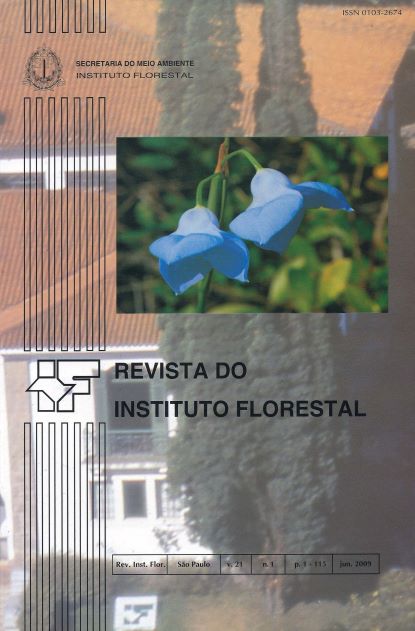COMPOSIÇÃO DAS COMUNIDADES DE AVES EM DUAS FLORESTAS SECUNDÁRIAS CONTÍGUAS NO SUDESTE DO BRASIL
DOI:
https://doi.org/10.24278/2178-5031.2009211203Palavras-chave:
Mata Atlântica, guildas, dinâmica fonte-raloResumo
Muitas décadas são necessárias até que uma floresta secundária apresente uma estrutura semelhante à de uma área em estádio avançado. Há espécies de aves florestais que dependem de florestas avançadas, enquanto outras utilizam florestas secundárias. Neste trabalho se compara a riqueza de espécies de aves, a estrutura trófica da comunidade e a presença de espécies de distribuição restrita em duas florestas secundárias contíguas, mas com estruturas de vegetação distintas: os parques estaduais Alberto Löfgren - PEAL e Cantareira - PEC. As aves foram amostradas em trajetos efetuados entre agosto de 2005 e dezembro de 2008, e a vegetação foi avaliada a partir de 100 pontos quadrantes por parque. A riqueza e o número de espécies de aves com distribuição restrita foram significativamente maiores no PEC. As guildas insetívoros do sub-bosque, insetívoros terrestres e frugívoros terrestres apresentaram riqueza menor de espécies no PEAL em relação ao PEC. Concluiu-se que a avifauna florestal do PEAL é um subconjunto da avifauna do PEC, que a vegetação menos desenvolvida do primeiro e dificuldades de estabelecimento de populações são as possíveis causas das diferenças observadas entre os parques e que ações de manejo podem aumentar a riqueza no PEAL, o que seria importante regionalmente.
Downloads
Referências
ALEIXO, A. Effects of selective logging on a bird community in the Brazilian Atlantic Forest. Condor, Santa Clara, v. 101, n. 2, p. 537-548, 1999.
______. Conservação da avifauna da Floresta Atlântica: efeitos da fragmentação e a importância de florestas secundárias. In: ALBUQUERQUE, J. L. B. et al. (Ed.). Ornitologia e conservação – da ciência às estratégias. Tubarão: Unisul, 2001. p. 199-206.
______.; VIELLIARD, J. M. E. Composição e dinâmica da avifauna da mata de Santa Genebra, Campinas, São Paulo, Brasil. Rev. Bras. Zool., Curitiba, v. 12, n. 3, p. 493-511, 1995.
ANTUNES, A. Z. Riqueza e dinâmica de aves endêmicas da Mata Atlântica em um fragmento de floresta estacional semidecidual no sudeste do Brasil. Rev. Bras. Orn., São Leopoldo, v. 15, n. 1, p. 61-68, 2007.
BENCKE, G. A. et al. (Org.). Áreas importantes para a conservação das aves no Brasil. Parte I – Estados do domínio da Mata Atlântica. São Paulo: SAVE Brasil, 2006. 494 p.
BLAKE, J. G.; LOISELLE, B. A. Bird assemblages in second-growth and old-growth forests, Costa Rica: perspectives from mist nets and point counts. Auk, Boston, v. 118, n. 2, p. 304-326, 2001.
BORGES, S. H.; STOUFFER, P. C. Bird communities in two types of anthropogenic sucessional vegetation in Central Amazonia. Condor, Santa Clara, v. 101, n. 3, p. 529-536, 1999.
CLAUSET, L. R. Paisagem paulista: áreas protegidas. São Paulo: Empresa das Artes, 1999. 185 p.
COMITÊ BRASILEIRO DE REGISTROS ORNITOLÓGICOS. Listas das aves do Brasil. Versão 05/10/2008. Disponível em: . Acesso em: 17 dez. 2008.
DE WALT, S.J.; MALIAKAL, S. K.; DENSLOW,J. S. Changes in vegetation structure and composition along a tropical forest chronosequence: implications for wildlife. Forest Ecology and Management, Amsterdam, v. 182, p. 139-151, 2003.
DUNN, R. R. Recovery of faunal communities during tropical forest regeneration. Conservation Biology, Cambridge, v. 18, n. 2, p. 302-309, 2004.
DURIGAN, G. Métodos para análise de vegetação arbórea. In: CULLEN Jr., L.; RUDRAN, R.; VALLADARES-PADUA, C. (Org.). Métodos de estudos em biologia da conservação & manejo da vida silvestre. Curitiba: Editora UFPR, 2003. p. 455-479.
GUARIGUATA, M. R.; OSTERTAG, R. Neotropical secondary forest succession: changes in structural and functional characteristics. Forest Ecology and Management, Amsterdam, v. 148, p. 185-206, 2001.
HARRIS, G. M.; PIMM, S. L. Bird species tolerance of secondary forest habitats and its effects on extinction. Conservation Biology, Cambridge, v. 18, n. 6, p. 1607-1616, 2004
HARRIS, G. M.; PIMM, S. L. Range size and extinction risk in forest birds. Conservation Biology, Cambridge, v. 22, n. 1, p. 163-171, 2007.
LIEBSCH, D.; GOLDENBERG, R.; MARQUES, M. C. M. Florística e estrutura de comunidades vegetais em uma cronoseqüência de Floresta Atlântica no Estado do Paraná, Brasil. Acta Botânica Brasílica, São Paulo, v. 21, n. 4, p. 983-992, 2007.
______.; MARQUES, M. C. M.; GOLDENBERG, R. How long does the Atlantic Rain Forest take to recover after a disturbance? Changes in species composition and ecological features during secondary succession. Biological Conservation, Barking, v. 141, n. 6, p. 1117-1125, 2008.
MAGURRAN, A. E. Ecological diversity and its measurement. Princeton: Princeton University Press, 1988. 179 p.
NEGREIROS, O. C. et al. Plano de manejo para o Parque Estadual da Cantareira. São Paulo: Instituto Florestal, 1974. 58 p. (Bol. Técn. IF, 10).
PARKER III, T. A.; STOTZ, D. F.; FITZPATRICK, J. W. Ecological and distributional databases. In: STOTZ, D. F. et al. (Ed.). Neotropical birds: ecology and conservation. Chicago: University of Chicago Press, 1996. p. 113-436.
PETIT, L. J. et al. Bird communities of natural and modified habitats in Panama. Ecography, Lund, v. 22, p. 292-304, 1999.
PROTOMASTRO, J. J. A test for preadaptation to human disturbances in the bird community of the Atlantic Forest. In: ALBUQUERQUE, J. L. B. et al. (Ed.). Ornitologia e conservação – da ciência às estratégias. Tubarão: Unisul, 2001. p. 179-198.
PULLIAM, H. R. Sources, sinks, and population regulation. American Naturalist, Chicago, v. 132, n. 5, p. 652-661, 1988.
RAHBECK, C. The relationship among area, elevation and regional species richness in neotropical birds. American Naturalist, Chicago, v. 149, n. 5, p. 875-902, 1997.
VENTURA, A.; BERENGUT, G.; VICTOR, M. A. M. Características edafo-climáticas das dependências do Serviço Florestal do Estado de São Paulo. Silvic. S. Paulo, São Paulo, v. 4/5, p. 57-140, 1965/66.
WILLIS, E. O. The composition of avian communities in remanescent woodlots in southern Brazil. Pap. Avuls. Zool, São Paulo, n. 33, p.1-25, 1979.
______.; ONIKI, Y. Nomes gerais para as aves brasileiras. Américo Brasiliense: Gráfica da Região, 1991. 55 p















